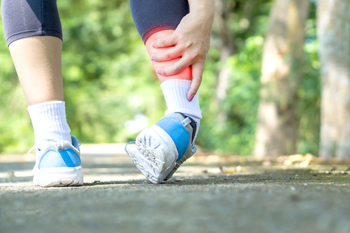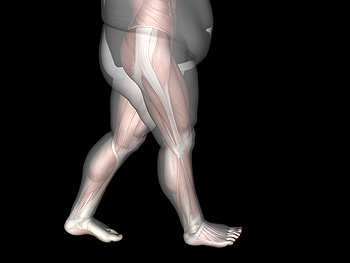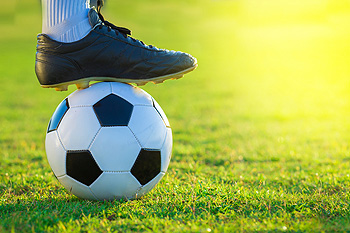Items filtered by date: May 2021
When Can I Go Back to Sports After an Ankle Sprain?
Ankle sprains are a common injury among those who participate in sports that require a lot of running, jumping, or turning. An ankle sprain can occur when one or more ligaments in the ankle overstretch or tear. Depending on the severity of the injury, symptoms may include pain, soreness, swelling, bruising, and difficulty bearing weight on the affected leg. Following an ankle sprain, it is very important to rest the ankle so that it can recover fully. Springing back into action without achieving full recovery can lead to reinjury and chronic ankle pain. If you have sprained your ankle, you can return to playing your sport following approval from your podiatrist. This will usually occur after swelling has gone down, you have normal strength, a full range of motion, and can comfortably bear weight on the affected leg. If you are an athlete and have sprained your ankle, it is suggested that you are under the care of a podiatrist.
Ankle sprains are common but need immediate attention. If you need your feet checked, contact Dr. John P. Beaupied from Palos Podiatry. Our doctor can provide the care you need to keep you pain-free and on your feet.
How Does an Ankle Sprain Occur?
Ankle sprains take place when the ligaments in your ankle are torn or stretched beyond their limits. There are multiple ways that the ankle can become injured, including twisting or rolling over onto your ankle, putting undue stress on it, or causing trauma to the ankle itself.
What Are the Symptoms?
- Mild to moderate bruising
- Limited mobility
- Swelling
- Discoloration of the skin (depending on severity)
Preventing a Sprain
- Wearing appropriate shoes for the occasion
- Stretching before exercises and sports
- Knowing your limits
Treatment of a Sprain
Treatment of a sprain depends on the severity. Many times, people are told to rest and remain off their feet completely, while others are given an air cast. If the sprain is very severe, surgery may be required.
If you have suffered an ankle sprain previously, you may want to consider additional support such as a brace and regular exercises to strengthen the ankle.
If you have any questions please feel free to contact our office located in Palos Heights, IL . We offer the newest diagnostic and treatment technologies for all your foot and ankle needs.
Tips to Avoid Running Injuries
 Running is a great form of exercise, but it can unfortunately lead to a variety of foot and ankle injuries. Luckily, there are steps that you can implement to help prevent running injuries. Prior to running, it is suggested that you warm up and do exercises to stretch and strengthen your foot and leg muscles. Footwear is also important. Look for high quality, well fitted running shoes that support your feet adequately. When you run, it is best to take things slow at first. Do not make sudden or drastic changes in the distance, duration, or intensity of your runs, as well as the terrain that you run on. Instead, slowly increase or change these things over time. For more information about how to prevent running injuries, consult with a podiatrist.
Running is a great form of exercise, but it can unfortunately lead to a variety of foot and ankle injuries. Luckily, there are steps that you can implement to help prevent running injuries. Prior to running, it is suggested that you warm up and do exercises to stretch and strengthen your foot and leg muscles. Footwear is also important. Look for high quality, well fitted running shoes that support your feet adequately. When you run, it is best to take things slow at first. Do not make sudden or drastic changes in the distance, duration, or intensity of your runs, as well as the terrain that you run on. Instead, slowly increase or change these things over time. For more information about how to prevent running injuries, consult with a podiatrist.
Exercising your feet regularly with the proper foot wear is a great way to prevent injuries. If you have any concerns about your feet, contact Dr. John P. Beaupied of Palos Podiatry. Our doctor will treat your foot and ankle needs.
How to Prevent Running Injuries
Many common running injuries are caused by overuse and overtraining. When the back of the kneecap starts wearing out and starts causing pain in your knee, this is commonly referred to as runner’s knee. Runner’s knee is a decrease in strength in your quadriceps and can occur if you’re not wearing properly fitted or supporting shoes. To prevent runner’s knee, focusing on hip strengthening is a good idea, as well as strengthening your quads to keep the kneecaps aligned.
What Are Some Causes of Running Injuries?
- One cause of a common running injury is called iliotibial band syndrome.
- Plantar fasciitis is also another common injury.
- Stress fractures can occur from overtraining, lack of calcium, or even your running style.
Best Ways to Prevent Running Injuries
- Wear footwear that fits properly and suits your running needs.
- Running shoes are the only protective gear that runners have to safeguard them from injury.
- Make a training schedule. Adding strengthening exercises as well as regular stretching can help keep you strong and limber and can lessen the possibility of injuries.
- Stretching keeps muscles limber; this will help you gain better flexibility.
If you have any questions please feel free to contact our office located in Palos Heights, IL . We offer the newest diagnostic and treatment technologies for all your foot and ankle needs.
Are Bunions Affecting Your Everyday Life?
Basic Foot Care Now Can Help Avoid Foot Problems in the Future
 You may not pay a lot of attention to your feet on a normal basis. However, showing your feet some love with basic foot care and the right footwear will help you avoid a variety of foot and ankle problems. Keep your feet clean, and always dry them fully before putting on socks to avoid fungal infections. Nails should be trimmed regularly and properly: straight across and not so short that they dig into the sides of the toe and possibly cause an ingrown toenail. Only wear shoes that are fitted properly and offer good heel and arch support, with enough room at the toe box for your toes to move around. High heels are not suggested and should not be worn every day, and block heels or kitten heels are better than stilettos. Ill-fitting shoes and the prolonged stress of high heels on your feet and toes can cause a variety of foot and ankle conditions. Inspect your feet as you are drying off from showering every day. If you notice any lesions, changes in appearance, or have any discomfort or pain, contact a podiatrist.
You may not pay a lot of attention to your feet on a normal basis. However, showing your feet some love with basic foot care and the right footwear will help you avoid a variety of foot and ankle problems. Keep your feet clean, and always dry them fully before putting on socks to avoid fungal infections. Nails should be trimmed regularly and properly: straight across and not so short that they dig into the sides of the toe and possibly cause an ingrown toenail. Only wear shoes that are fitted properly and offer good heel and arch support, with enough room at the toe box for your toes to move around. High heels are not suggested and should not be worn every day, and block heels or kitten heels are better than stilettos. Ill-fitting shoes and the prolonged stress of high heels on your feet and toes can cause a variety of foot and ankle conditions. Inspect your feet as you are drying off from showering every day. If you notice any lesions, changes in appearance, or have any discomfort or pain, contact a podiatrist.
Everyday foot care is very important to prevent infection and other foot ailments. If you need your feet checked, contact Dr. John P. Beaupied from Palos Podiatry. Our doctor can provide the care you need to keep you pain-free and on your feet.
Everyday Foot Care
Often, people take care of their bodies, face and hair more so than they do for their feet. But the feet are a very important aspect of our bodies, and one that we should pay more attention to. Without our feet, we would not be able to perform most daily tasks.
It is best to check your feet regularly to make sure there are no new bruises or cuts that you may not have noticed before. For dry feet, moisturizer can easily be a remedy and can be applied as often as necessary to the affected areas. Wearing shoes that fit well can also help you maintain good foot health, as well as making it easier to walk and do daily activities without the stress or pain of ill-fitting shoes, high heels, or even flip flops. Wearing clean socks with closed shoes is important to ensure that sweat and bacteria do not accumulate within the shoe. Clean socks help to prevent Athlete’s foot, fungi problems, bad odors, and can absorb sweat.
If you have any questions please feel free to contact our office located in Palos Heights, IL . We offer the newest diagnostic and treatment technologies for all your foot and ankle needs.
Obesity and Foot Pain
 The feet are made up of twenty-six bones, numerous ligaments, tendons, and muscles, and they bear the weight of the body. Because of this, obesity can negatively affect the feet. Patients who are overweight may notice their feet have become larger, and flat feet may gradually develop. A type of arthritis which is referred to as gout may appear from eating unhealthy foods that can lead to excess uric acid in the blood. This condition often affects the joints in the big toe, which can cause severe pain and discomfort. Additionally, plantar fasciitis affects the heel and arch of the foot, and custom made orthotics may have to be worn that can alleviate the pain that is associated with this ailment. If you are overweight, and have any type of foot pain, it is strongly advised that you seek the counsel of a podiatrist who can help you with correct treatment options.
The feet are made up of twenty-six bones, numerous ligaments, tendons, and muscles, and they bear the weight of the body. Because of this, obesity can negatively affect the feet. Patients who are overweight may notice their feet have become larger, and flat feet may gradually develop. A type of arthritis which is referred to as gout may appear from eating unhealthy foods that can lead to excess uric acid in the blood. This condition often affects the joints in the big toe, which can cause severe pain and discomfort. Additionally, plantar fasciitis affects the heel and arch of the foot, and custom made orthotics may have to be worn that can alleviate the pain that is associated with this ailment. If you are overweight, and have any type of foot pain, it is strongly advised that you seek the counsel of a podiatrist who can help you with correct treatment options.
The more you weigh, the harder your feet must work to support your body. If you’re an obese individual and are concerned about your feet, contact Dr. John P. Beaupied from Palos Podiatry. Our doctor can provide the care you need to keep you pain-free and on your feet.
Obesity and Your Feet
People who are overweight are putting more pressure on their ankles, knees, and hips as well as their feet. This unfortunately can lead to variety of different issues.
Problems & Complications Stemming from Obesity
- When the body is overweight, it tries to compensate by changing the way that it moves. An obese person may lean forward and put extra weight on the wrong part of the foot. This puts unnecessary stress on the feet.
- Obese people are also more likely to develop type II diabetes which is a condition that causes a lot of foot problems. People with diabetes often don’t feel the cuts and sores that they may have on their feet, which can lead to more complicated and severe issues.
- Plantar fasciitis is another foot condition that can be caused by obesity. Plantar fasciitis is an inflammation of the tissue along the bottom of the foot, which causes pain and stiffness while walking and climbing stairs.
If you have any questions, please feel free to contact our office located in Palos Heights, IL . We offer the newest diagnostic and treatment technologies for all your foot care needs.





